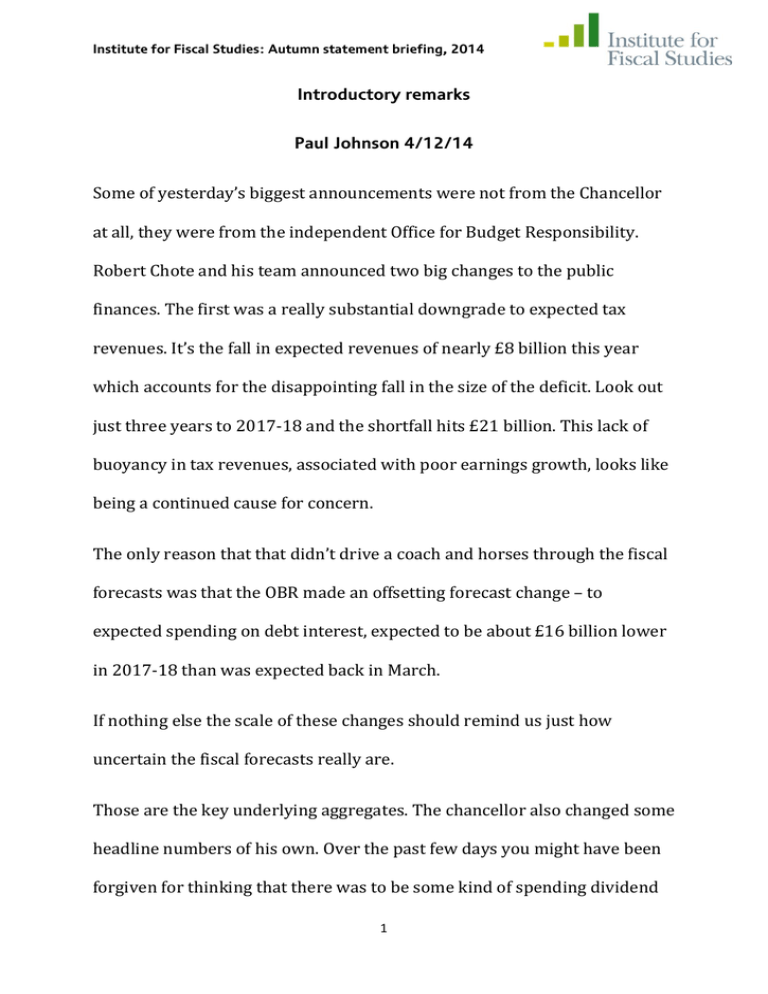Introductory remarks Paul Johnson 4/12/14
advertisement

Institute for Fiscal Studies: Autumn statement briefing, 2014 Introductory remarks Paul Johnson 4/12/14 Some of yesterday’s biggest announcements were not from the Chancellor at all, they were from the independent Office for Budget Responsibility. Robert Chote and his team announced two big changes to the public finances. The first was a really substantial downgrade to expected tax revenues. It’s the fall in expected revenues of nearly £8 billion this year which accounts for the disappointing fall in the size of the deficit. Look out just three years to 2017-18 and the shortfall hits £21 billion. This lack of buoyancy in tax revenues, associated with poor earnings growth, looks like being a continued cause for concern. The only reason that that didn’t drive a coach and horses through the fiscal forecasts was that the OBR made an offsetting forecast change – to expected spending on debt interest, expected to be about £16 billion lower in 2017-18 than was expected back in March. If nothing else the scale of these changes should remind us just how uncertain the fiscal forecasts really are. Those are the key underlying aggregates. The chancellor also changed some headline numbers of his own. Over the past few days you might have been forgiven for thinking that there was to be some kind of spending dividend 1 Institute for Fiscal Studies: Autumn statement briefing, 2014 to come. More money announced for the NHS, much made of how transport and flood defence spending is to be allocated. That is not the story the numbers tell. There is actually to be a slight increase in the speed of proposed spending cuts after 2015-16. In addition the numbers have been pushed out to 201920 for the first time. With a presumption that total spending will be unchanged, the implication is that there will be yet another year’s worth of cuts in public service spending. So there is no spending dividend on the horizon. Far from it. There are huge cuts to come. On these plans, whatever way you look at it, we are considerably less than half way through the cuts. Let’s look in more detail at some of the specifics. The deficit The headline of course is that the deficit is now expected to be over £90 billion this year, a fall of only £6 billion on last year’s number. As the OBR notes this would be “the second smallest year-on-year reduction since its peak in 2009-10, despite this being the strongest year for GDP growth”. 2 Institute for Fiscal Studies: Autumn statement briefing, 2014 This is disappointing compared with forecasts in March. It is massively more disappointing compared with forecasts back in 2010 which foresaw a deficit of less than £40 billion in 2014-15. It is important to understand why the deficit hasn’t fallen. It is emphatically not because the government has failed to impose the intended spending cuts. It is because the economy performed so poorly in the first half of the parliament, hitting revenues very hard. Unless the government could have found some economic magic which would have made a substantial difference to growth over the last few years, the only way it could have presided over a greater fall in the deficit would have been to cut spending harder or to raise taxes further. Looking forward the forecasts imply reaching cyclically adjusted current budget surplus in 2017-18, overall balance in 2018-19 and, supposedly, an overall surplus of £23 billion by 2019-20. Note that we are not really talking about the fiscal rules any more. The current fiscal mandate – to be in cyclically adjusted current budget balance at the end of the five year horizon – is not at all binding in these circumstances. The plan is to overachieve on it. 3 Institute for Fiscal Studies: Autumn statement briefing, 2014 Spending How do we get to this sunlit upland in which we have a budget surplus? Spending cuts on a colossal scale is how, taking total government spending to its lowest level as a proportion of national income since before the last war. As ever there are different ways of looking at the scale of cuts. If you look at total government spending less spending on debt interest (a measure the prime minister has used at times) then spending is down by £11 billion in the four years to 2014-15, and is due to fall a further £38 billion in the five years to 2019-20. The relatively modest fall over this parliament is largely explained by increased spending on social security, especially pensions. If you look specifically at spending by Whitehall departments, then about £35 billion of cuts have happened, with £55 billion to come. Of course not all this change need happen through cuts to departmental spending. Cuts in social security, or tax increases, could help fill the hole. We calculate that, just to keep the pace of departmental spending cuts over the next parliament to that which has been achieved over this parliament – that is cutting at just over 2% a year – would require welfare cuts and or tax rises of about £21 billion a year by 2019-20. The Conservatives have 4 Institute for Fiscal Studies: Autumn statement briefing, 2014 promised, largely unspecified, welfare cuts of £12 billion, but partially offset by tax cuts of £7 billion. The Chancellor is right to point out that it has proved possible to implement substantial cuts over this parliament. One cannot just look at the scale of implied cuts going forward and say they are unachievable. But it is surely incumbent upon anyone set on taking the size of the state to its smallest in many generations to tell us what that means. How will these cuts be implemented? What will local government, the defence force, the transport system, look like in this world? Is this a fundamental reimagining of the role of the state? One thing is for sure. If we move in anything like this direction, whilst continuing to protect health and pensions, the role and shape of the state will have changed beyond recognition. We think that on the plans set out yesterday by 2019-20 a third of all state spending will go just on health and state pensions, up from a quarter not long before the crisis. And that’s without any additional spending being allocated to the NHS. Specific measures In fiscal terms none of the specific measures announced yesterday was huge. Given the lack of available money and the proximity of the election 5 Institute for Fiscal Studies: Autumn statement briefing, 2014 that is not surprising. Despite their modest size a few of the measures are worth focussing on. Stamp Duty The changes to stamp duty are welcome, but really rather modest. They are welcome because they remove the absurd slab structure which, at the extreme, could result in a £40,000 additional tax bill accompanying a £1 increase in sale price. They are modest because they leave the system as a whole largely intact, raising large sums of money, and distorting the housing market. Indeed revenues from Stamp Duty on residential property are still expected to increase from £7 billion in 2013-14 to £16 billion in 2019-20. Transaction taxes such as stamp duty are highly inefficient however they are designed and the truth is Stamp Duty will continue to become a more important revenue raiser not a less important one even after these changes. This is most certainly not the substantial overhaul of the taxation of housing we need. It is also worth mentioning that the same slab structure which applies to non-residential property has not been reformed. That seems odd. Business taxes 6 Institute for Fiscal Studies: Autumn statement briefing, 2014 There was quite a lot of action on business taxes yesterday. Not much of it will have added to the stability and certainty that is the hallmark of a good system of business taxation. In revenue terms the biggest change would appear to be the capping at 50% of the proportion of banks’ annual taxable profits that can be offset against prior losses. This is intended to stop some banks paying no corporation tax for a very long time as they carry forward losses made during the crisis. At first sight this would seem close to being a windfall tax, aimed rather arbitrarily at the subset of banks which made big losses. But actually in the long run its effect is to bring payments forward, not to increase them. The public finance numbers we see are flattered; the additional revenues will not be available in the long run. Structurally the diverted profits tax – the so called “google tax” – is potentially the biggest change. This is rather like an anti avoidance measure. It will impose an additional 25% tax where companies have economic substance in the UK but where profits are being artificially diverted offshore. Exactly what this means and how it will work remains to be seen. The thinking behind it is understandable. The complexity that is likely to be created is considerable. 7 Institute for Fiscal Studies: Autumn statement briefing, 2014 It is also worth mentioning the reduction to the supplementary charge levied on North Sea Oil production. This is notable less for the reduction itself than for the quiet abandonment of the so called fair fuel stabiliser introduced when the supplementary charge was increased back in 2011. The idea was supposed to be that when oil prices were high oil producers would pay more tax on their profits while motorists wouldn’t see excise taxes exacerbate the effect of high prices. Low oil prices should have seen cuts in the tax on oil producers but rises in fuel duties. The latter is not happening. This does little for the credibility of such commitments. Postgraduate loans Let’s finish by looking at one other change announced yesterday – the introduction of a system of loans for postgraduates. The number of UK students obtaining taught postgraduate qualifications has doubled since 1999. Connoisseurs of the IFS oeuvre will know that we have calculated that one of the features of the current system of undergraduate loans is that perhaps 40% of the money loaned will not be paid back, with up to three quarters of graduates never paying the loan back in full. This has obvious consequences for the public finances. Is the same likely to be true of postgraduate loans? 8 Institute for Fiscal Studies: Autumn statement briefing, 2014 Probably not. The loans are smaller, postgraduates earn more, and the government’s illustrative scheme charges a higher interest rate. Our initial modelling suggests the long term cost of the illustrative scheme should be modest. But it is worth saying that those who take out the loan would face rather high effective marginal withdrawal rates on earnings of 50% for basic rate taxpayers (20% income tax, plus 12% NI, plus 9% repayment of undergraduate loan, plus 9% repayment of postgraduate loan) and 60% for higher rate taxpayers. 9



